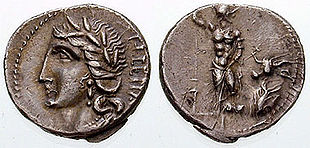| Marsian | |
|---|---|
| Native to | Marruvium |
| Region | Marsica in Abruzzo |
| Ethnicity | Marsi |
| Era | 300-150 BC |
| Language family | Indo-European
|
| Writing system | Inscriptions in votive offerings |
| Language codes | |
| ISO 639-3 | ims |
| Linguist List | ims |
| Glottolog | mars1253 |
 Marsian Marsian | |

The Marsian language is the extinct language of the Marsi. It is classified by the Linguist List as one of the Umbrian group of languages.
Phonology
Their language differs very slightly from Roman Latin of that date; for apparently contracted forms, such as Fougno instead of Fucino, may really only be a matter of spelling. In final syllables, the diphthongs ai, ei, and oi all appear as e. On the other hand, the older form of the name of the tribe (dat. plur. Martses = Lat. Martiis) shows its derivation and exhibits the assibilation of -tio- into -tso-, proper to the Oscan language but strange to classical Latin.
Corpus
The Marsian inscriptions are dated by the style of the alphabet from about 300 to 150 BC (the middle Roman Republic). Conway lists nine inscriptions, one from Ortona and two each from Marruvium, Lecce, Trasacco and Luco. In addition, there are a few glosses, a few place names and a few dozen personal names in Latin form.
Bronze of Lake Fucinus

The Bronze of Lake Fucinus was an inscribed bronze plaque found in 1877 near Luco during the draining of the lake, from an ancient settlement that had been covered by the lake. The bronze was placed in the Museum of Prince Alessandro Torlonia, where it was photographed for publication. It was lost in 1894 and it has not been seen since. The text of the plaque is as follows:
- caso cantouio | s aprufclano cei | p apur finem e..| salicom
- en ur | bid casontonio | socieque dono | m ato.er.actia | pro
- lenibus mar | tses.
It seems to be or describe a votive offering (donom) perhaps of boars (apruf) to the local goddess(es) Anctia (actia) on behalf of the Marsian Legions (pro lenibus martses).
Notes
- For the phonetic transcription from Oscan to Latin alphabet see, for example, this page Archived 2015-10-25 at the Wayback Machine or this one. All of the Oscan monetary legends are retrograde, just like the one running clockwise on the copy reproduced in the margin.
References
- "Marsian". LINGUIST List. Archived from the original on 14 April 2015. Retrieved 6 September 2024.
300-150 BC.
- ^ Conway 1897, pp. 289–299.
- Conway 1911
Bibliography
- Conway, Robert Seymour (1897). The Italic Dialects Edited with a Grammar and Glossary. Cambridge: University Press. pp. 289–299.
- Attribution
 This article incorporates text from a publication now in the public domain: Conway, Robert Seymour (1911). "Marsi". In Chisholm, Hugh (ed.). Encyclopædia Britannica. Vol. 17 (11th ed.). Cambridge University Press. Endnote:
This article incorporates text from a publication now in the public domain: Conway, Robert Seymour (1911). "Marsi". In Chisholm, Hugh (ed.). Encyclopædia Britannica. Vol. 17 (11th ed.). Cambridge University Press. Endnote:
- Conway, R. S. The Italic Dialects. pp. 290 seq. (from which some portions of this article are taken; on the Fucino-Bronze, ib. p. 294)
| Italic languages | |
|---|---|
| Latino-Faliscan |
|
| Osco-Umbrian |
|
| Unknown |
|
| Reconstructed | |
| All Italic languages except Latin (and its descendants, the Romance languages) are now extinct; Latin is still used as a liturgical language of the Catholic Church. | |
This Indo-European languages-related article is a stub. You can help Misplaced Pages by expanding it. |
This ancient Rome–related article is a stub. You can help Misplaced Pages by expanding it. |